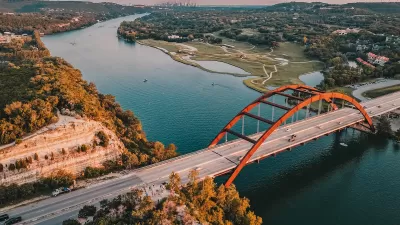Hillary Clinton recently proposed the creation of a national infrastructure bank—an idea also put forward several times by the Obama Administration. Posts by Vox and City Observatory put the idea under a microscope.
Matthew Yglesias (writing for Vox) and Joe Cortright (writing for City Observatory take different approaches to their analysis of an infrastructure policy that would rely on a national infrastructure bank for some of its funding capability.
Yglesias mostly provides an explanation of the concept by way of a larger infrastructure platform proposed by presidential candidate Hillary Clinton a few weeks ago.
After pointing out a few of the way infrastructure bank proposals can differ, Yglesias notes a common characteristic of all of them: "All flavors of infrastructure bank, however, are designed to solve a fundamental mismatch between which kinds of investors want to buy municipal bonds and which kinds of investors are best suited to invest in projects whose payoffs are very long-term."
As for "Clinton's particular flavor of infrastructure bank," according to Yglesias, it "would focus on projects of regional and national significance, emphasizing investments in complex multi-modal projects like freight and port improvements, and in projects to modernize our energy, water, broadband, and transportation systems in urban and rural communities."
Cortright, however, provides a clear polemic about the shortcomings of the national infrastructure bank model. Cortight's argument, summed up generally, is that there are several practical considerations that will limit the effectiveness of the infrastructure bank. Cortright goes into a lot more depth on each of the considerations listed here:
- A bank has to be capitalized.
- Banks want to be paid back.
- A bank may mostly substitute for existing financing rather than prompting additional investment.
- Banks don’t design projects, DOTs do.
- Cheap money creates its own incentive problems.
- And it’s not like states haven’t figured out how to borrow money.
Cortright concludes his argument by following up on that last point—most states are already deeply in debt for large infrastructure projects.
FULL STORY: Don’t bank on it

Alabama: Trump Terminates Settlements for Black Communities Harmed By Raw Sewage
Trump deemed the landmark civil rights agreement “illegal DEI and environmental justice policy.”

Study: Maui’s Plan to Convert Vacation Rentals to Long-Term Housing Could Cause Nearly $1 Billion Economic Loss
The plan would reduce visitor accommodation by 25% resulting in 1,900 jobs lost.

Planetizen Federal Action Tracker
A weekly monitor of how Trump’s orders and actions are impacting planners and planning in America.

Wind Energy on the Rise Despite Federal Policy Reversal
The Trump administration is revoking federal support for renewable energy, but demand for new projects continues unabated.

Passengers Flock to Caltrain After Electrification
The new electric trains are running faster and more reliably, leading to strong ridership growth on the Bay Area rail system.

Texas Churches Rally Behind ‘Yes in God’s Back Yard’ Legislation
Religious leaders want the state to reduce zoning regulations to streamline leasing church-owned land to housing developers.
Urban Design for Planners 1: Software Tools
This six-course series explores essential urban design concepts using open source software and equips planners with the tools they need to participate fully in the urban design process.
Planning for Universal Design
Learn the tools for implementing Universal Design in planning regulations.
Caltrans
Smith Gee Studio
Institute for Housing and Urban Development Studies (IHS)
City of Grandview
Harvard GSD Executive Education
Toledo-Lucas County Plan Commissions
Salt Lake City
NYU Wagner Graduate School of Public Service





























